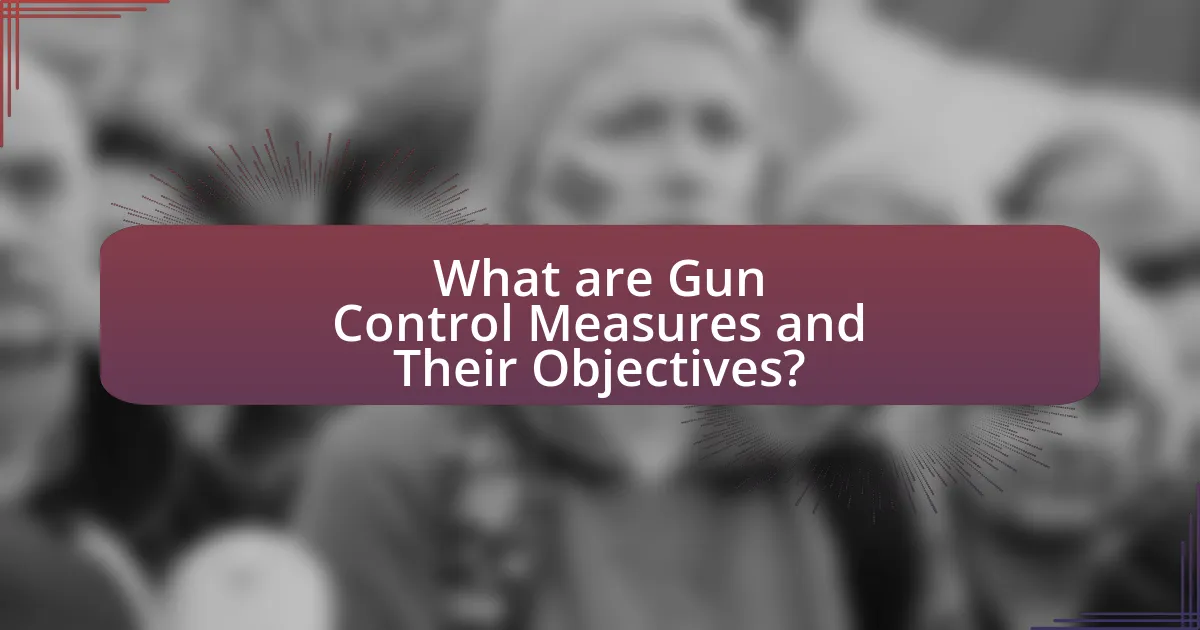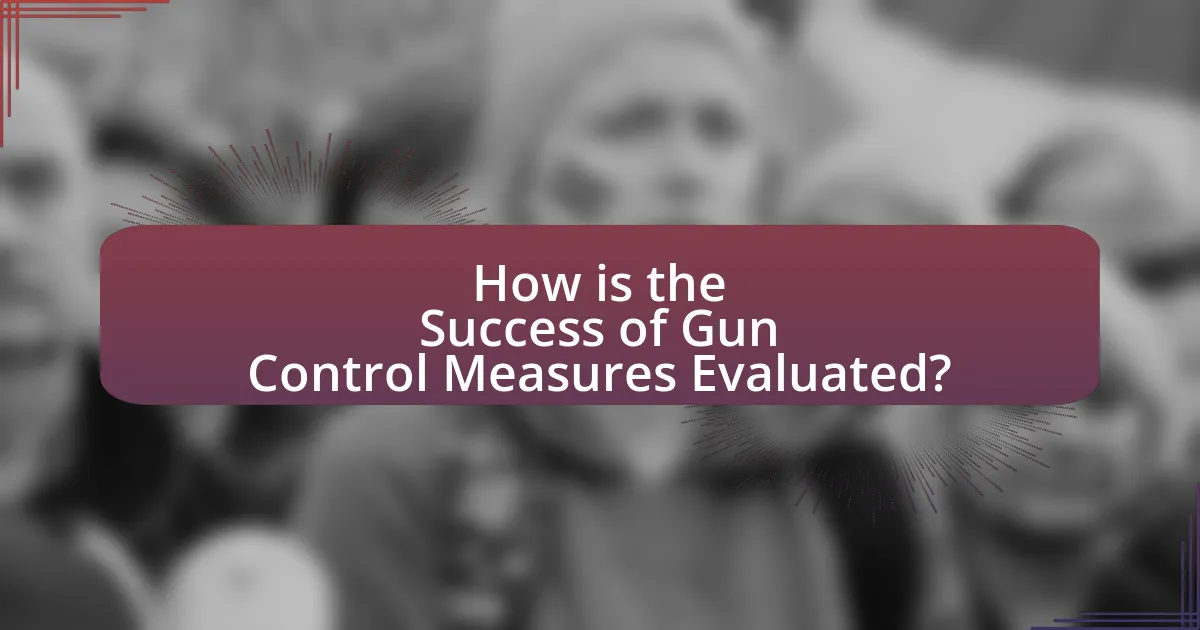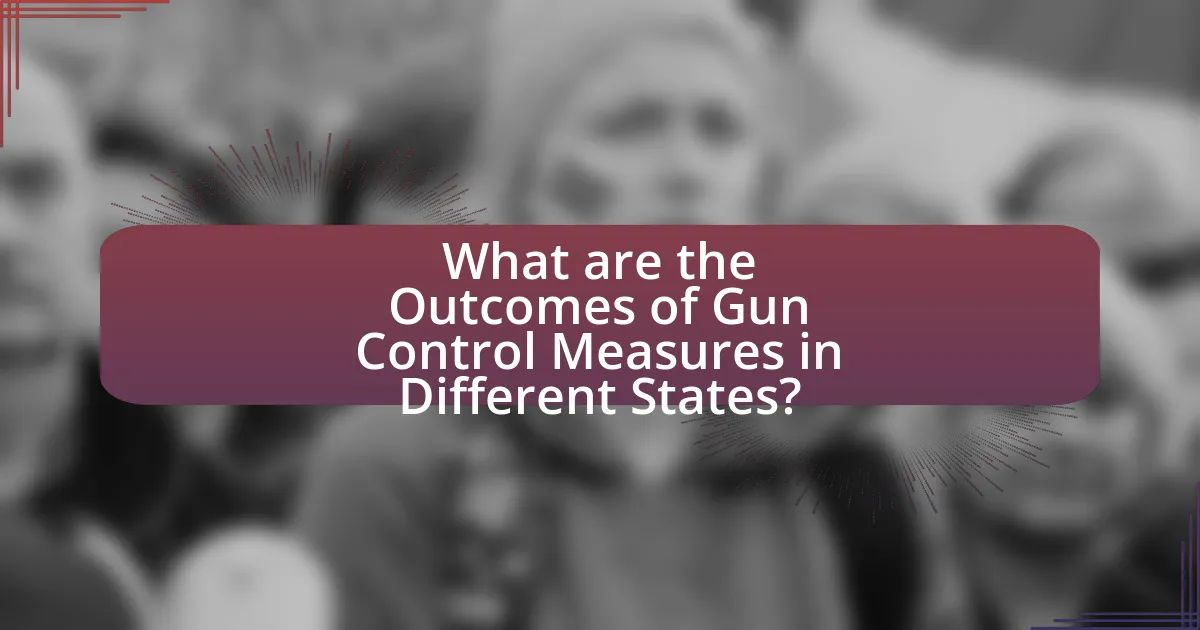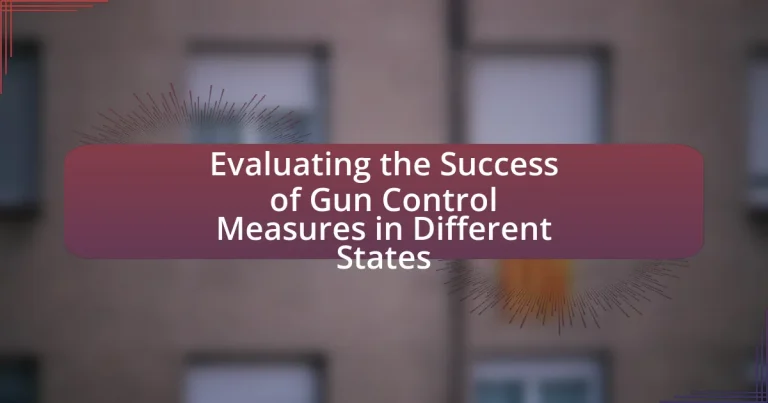Gun control measures are laws and policies designed to regulate the sale, possession, and use of firearms, primarily aimed at reducing gun violence and enhancing public safety. The article evaluates the effectiveness of these measures across different states, highlighting the varying implementation and outcomes, such as the correlation between stricter laws and lower rates of gun-related deaths. It discusses common types of gun control measures, the statistical evidence supporting their necessity, and the challenges in measuring their success. Additionally, the article examines the lessons learned from different states’ experiences, best practices for evaluation, and the importance of stakeholder collaboration in improving gun control policies.

What are Gun Control Measures and Their Objectives?
Gun control measures are laws and policies aimed at regulating the sale, possession, and use of firearms. Their primary objectives include reducing gun violence, preventing access to firearms by individuals deemed a risk to themselves or others, and promoting public safety. For instance, studies have shown that states with stricter gun laws, such as background checks and waiting periods, often experience lower rates of gun-related deaths. According to a 2019 study published in the American Journal of Public Health, states with comprehensive background check laws saw a 15% reduction in firearm homicides compared to those without such measures.
How do different states implement gun control measures?
Different states implement gun control measures through a variety of laws and regulations that govern the purchase, ownership, and carrying of firearms. For example, California enforces strict background checks, a 10-day waiting period for gun purchases, and bans on certain types of firearms, while Texas allows open carry and has fewer restrictions on gun ownership. Research from the Giffords Law Center indicates that states with stricter gun laws tend to have lower rates of gun deaths, supporting the effectiveness of these measures in reducing firearm-related incidents.
What types of gun control measures are commonly enacted?
Commonly enacted gun control measures include background checks, waiting periods, restrictions on certain types of firearms, and licensing requirements. Background checks are mandated in many states to ensure that individuals prohibited from owning firearms, such as felons or those with restraining orders, cannot purchase guns. Waiting periods, which require a delay between the purchase and delivery of a firearm, aim to reduce impulsive acts of violence. Restrictions on certain types of firearms, such as assault weapons and high-capacity magazines, are implemented to limit access to weapons deemed particularly dangerous. Licensing requirements often involve training and testing to ensure responsible gun ownership. These measures are supported by various studies indicating that states with stricter gun laws tend to have lower rates of gun violence and firearm-related deaths.
How do these measures vary from state to state?
Gun control measures vary significantly from state to state, with some states implementing strict regulations while others maintain minimal restrictions. For example, California enforces comprehensive background checks, waiting periods, and restrictions on assault weapons, whereas states like Texas have more permissive laws, allowing open carry and minimal background checks. This disparity is evidenced by the differing rates of gun violence; states with stricter gun laws, such as New York, often report lower gun-related deaths compared to states with looser regulations, like Louisiana, which has one of the highest rates of gun fatalities in the country.
Why are gun control measures considered necessary?
Gun control measures are considered necessary to enhance public safety and reduce gun violence. Research indicates that states with stricter gun laws experience lower rates of firearm-related deaths. For instance, a study published in the American Journal of Public Health found that states with comprehensive background check laws had a 35% lower rate of gun homicides compared to states without such measures. This evidence supports the argument that implementing gun control can lead to significant reductions in gun-related incidents, thereby protecting communities and saving lives.
What statistics support the need for gun control?
Statistics supporting the need for gun control include that countries with stricter gun laws, such as Australia, have seen a significant reduction in gun-related deaths, with a 59% decrease in firearm homicides following the implementation of strict gun laws in 1996. Additionally, research from the American Journal of Public Health indicates that for every 1% increase in gun ownership, there is a corresponding 0.9% increase in firearm homicides. Furthermore, a study by the Centers for Disease Control and Prevention found that states with higher rates of gun ownership have higher rates of gun deaths, highlighting a direct correlation between gun prevalence and violence. These statistics underscore the argument for implementing stricter gun control measures to enhance public safety.
How do gun control measures aim to reduce violence?
Gun control measures aim to reduce violence by implementing regulations that limit access to firearms, thereby decreasing the likelihood of gun-related incidents. These measures include background checks, waiting periods, and restrictions on certain types of firearms. Research indicates that states with stricter gun laws experience lower rates of gun violence; for example, a study published in the American Journal of Public Health found that states with comprehensive background check laws had a 35% lower rate of gun homicides compared to states without such laws. This evidence supports the effectiveness of gun control measures in mitigating violence.

How is the Success of Gun Control Measures Evaluated?
The success of gun control measures is evaluated through a combination of statistical analysis, crime rate assessments, and public health outcomes. Researchers analyze data on gun-related incidents, including homicides, suicides, and accidental shootings, before and after the implementation of specific laws. For instance, studies have shown that states with stricter gun laws, such as California and New York, often report lower rates of gun violence compared to states with more lenient regulations, like Texas and Florida. Additionally, public health metrics, such as emergency room visits for gun-related injuries, are monitored to assess the impact of these measures on community safety. This multifaceted approach provides a comprehensive understanding of the effectiveness of gun control policies.
What metrics are used to assess the effectiveness of gun control measures?
Metrics used to assess the effectiveness of gun control measures include rates of gun-related homicides, suicides, and mass shootings, as well as changes in gun ownership and firearm-related injuries. These metrics provide quantifiable data to evaluate the impact of specific laws and regulations. For instance, studies have shown that states with stricter gun laws often report lower rates of gun deaths; for example, a 2019 study published in the American Journal of Public Health found that states with universal background checks had a 15% lower firearm homicide rate compared to those without such laws. Additionally, the correlation between gun control measures and reductions in gun violence can be analyzed through longitudinal studies that track changes over time in relation to the implementation of specific policies.
How do crime rates factor into the evaluation?
Crime rates are a critical metric in evaluating the success of gun control measures across different states. They provide quantifiable data that reflects the impact of legislation on public safety and crime trends. For instance, states that have implemented stricter gun control laws often report a decrease in gun-related homicides and violent crimes, supporting the argument that such measures can lead to improved safety outcomes. A study by the Center for Disease Control and Prevention found that states with comprehensive background checks and restrictions on high-capacity magazines experienced a 25% reduction in gun deaths compared to states with more lenient laws. This correlation between crime rates and gun control effectiveness underscores the importance of analyzing crime statistics when assessing the overall success of these measures.
What role do public health outcomes play in this assessment?
Public health outcomes are critical in assessing the success of gun control measures, as they provide measurable indicators of the impact of these policies on community health and safety. For instance, reductions in gun-related injuries and fatalities serve as direct evidence of the effectiveness of implemented regulations. Studies have shown that states with stricter gun laws often report lower rates of gun violence and associated health complications, highlighting the correlation between legislative action and public health improvements. This data-driven approach allows policymakers to evaluate the efficacy of gun control measures and make informed decisions to enhance public safety.
Why is it important to evaluate the success of these measures?
Evaluating the success of gun control measures is crucial to determine their effectiveness in reducing gun violence and enhancing public safety. This assessment allows policymakers to identify which strategies work, enabling them to allocate resources efficiently and implement evidence-based practices. For instance, studies have shown that states with stricter gun laws, such as California, have experienced lower rates of gun-related deaths compared to states with more lenient regulations, highlighting the importance of evaluating these measures to inform future legislation.
How can evaluations influence future legislation?
Evaluations can influence future legislation by providing data-driven insights that highlight the effectiveness or shortcomings of existing laws. For instance, comprehensive evaluations of gun control measures in various states can reveal correlations between specific regulations and outcomes such as crime rates or gun-related incidents. These findings can inform lawmakers about which policies are successful and which need revision or replacement, thereby shaping future legislative agendas. Historical examples, such as the evaluation of California’s gun laws, have shown a decrease in gun violence, prompting other states to consider similar regulations based on empirical evidence.
What challenges exist in measuring success?
Measuring success in evaluating gun control measures presents several challenges, primarily due to the complexity of defining success itself. Success can vary widely based on metrics such as reduced gun violence, changes in crime rates, or public perception, making it difficult to establish a standardized measurement framework. Additionally, external factors like socioeconomic conditions, law enforcement practices, and cultural attitudes towards guns can influence outcomes, complicating the attribution of success directly to gun control measures. For instance, a study by the RAND Corporation in 2018 highlighted that varying state laws and enforcement levels lead to inconsistent data, which hampers comparative analysis across states. This variability underscores the need for a nuanced approach to measuring success that accounts for these diverse influences.

What are the Outcomes of Gun Control Measures in Different States?
Gun control measures in different states have led to varying outcomes, primarily influencing rates of gun violence and firearm-related deaths. For instance, states with stricter gun laws, such as California and New York, have reported lower rates of gun deaths compared to states with more lenient regulations, like Texas and Florida. According to a 2021 study published in the American Journal of Public Health, states with comprehensive background checks and restrictions on high-capacity magazines experienced a 15% reduction in gun homicide rates. Additionally, research from the Giffords Law Center indicates that states with stronger gun laws see fewer mass shootings and lower rates of suicide by firearm. These findings illustrate that the implementation of gun control measures can significantly impact public safety and health outcomes across different states.
How have specific states fared with their gun control measures?
States with strict gun control measures, such as California and New York, have generally seen lower rates of gun violence compared to states with more lenient laws, like Texas and Florida. For instance, California’s comprehensive background check system and restrictions on assault weapons have contributed to a gun homicide rate of 3.9 per 100,000 people in 2020, significantly lower than Texas’s rate of 4.2 per 100,000. Additionally, New York’s SAFE Act, implemented in 2013, has been associated with a decline in gun-related deaths, with a 2019 report indicating a 30% reduction in gun homicides since its enactment. Conversely, states with fewer restrictions often experience higher rates of gun violence; for example, Florida’s gun homicide rate was 5.6 per 100,000 in 2020. These statistics illustrate the varying effectiveness of gun control measures across different states.
What successes have been reported in states with strict gun laws?
States with strict gun laws have reported significant reductions in gun-related deaths and injuries. For instance, California, which has implemented comprehensive gun control measures, experienced a 37% decrease in gun homicides from 2006 to 2016, according to a study published in the American Journal of Public Health. Additionally, Massachusetts has seen a 40% decline in firearm-related deaths since enacting stricter regulations in the 1990s, as reported by the Center for Disease Control and Prevention. These statistics demonstrate that stringent gun laws can effectively contribute to lower rates of gun violence.
What failures or challenges have been observed in other states?
Failures and challenges observed in other states regarding gun control measures include ineffective implementation, lack of enforcement, and insufficient public support. For instance, in California, despite stringent gun laws, the state has faced challenges with illegal firearms trafficking, which undermines the effectiveness of regulations. Additionally, studies have shown that states like New York, which enacted strict gun control laws, still experience high rates of gun violence, indicating that legislation alone may not address underlying issues such as socioeconomic factors and mental health. Furthermore, in states like Texas, the lack of universal background checks has led to loopholes that allow individuals to acquire firearms without proper vetting, contributing to increased gun-related incidents. These examples highlight the complexities and limitations of gun control measures across different states.
What lessons can be learned from the experiences of different states?
Different states provide valuable lessons on the effectiveness of gun control measures, highlighting the correlation between legislation and outcomes. For instance, states like California and New York, which have implemented strict gun laws, report lower rates of gun violence compared to states with more lenient regulations, such as Texas and Florida. Research from the Center for Disease Control and Prevention indicates that states with comprehensive background checks and waiting periods experience a significant reduction in firearm homicides. Additionally, the experiences of states demonstrate that community engagement and education about gun safety can enhance the effectiveness of these laws, as seen in Massachusetts, where public awareness campaigns have contributed to a decline in gun-related incidents.
How can successful strategies be replicated in other regions?
Successful strategies can be replicated in other regions by conducting thorough assessments of the original strategies’ components, adapting them to local contexts, and ensuring stakeholder engagement. For instance, the implementation of universal background checks in states like California has shown a reduction in gun violence, which can be analyzed and tailored to fit the specific legal, cultural, and demographic factors of other regions. Research from the Center for Disease Control and Prevention indicates that states with stricter gun laws experience lower rates of firearm deaths, providing a factual basis for the effectiveness of such strategies. By utilizing data-driven approaches and community involvement, regions can effectively adapt and implement successful gun control measures.
What common pitfalls should be avoided based on past evaluations?
Common pitfalls to avoid based on past evaluations of gun control measures include over-reliance on correlation without causation, neglecting the importance of comprehensive data collection, and failing to consider the socio-economic context of different states. Over-reliance on correlation can lead to misleading conclusions about the effectiveness of gun laws, as seen in studies where states with strict laws did not always show a corresponding decrease in gun violence. Comprehensive data collection is crucial; for instance, evaluations that lacked detailed demographic and crime data often resulted in incomplete analyses. Additionally, ignoring socio-economic factors, such as poverty and education levels, can skew results, as these elements significantly influence crime rates and the effectiveness of gun control measures.
What are best practices for evaluating gun control measures effectively?
Best practices for evaluating gun control measures effectively include utilizing comprehensive data analysis, employing rigorous research methodologies, and considering diverse stakeholder perspectives. Comprehensive data analysis involves collecting and examining statistics on gun violence, crime rates, and public health outcomes before and after the implementation of gun control measures. For instance, studies such as the one published in the American Journal of Public Health in 2013 demonstrated that states with stricter gun laws experienced lower rates of gun-related deaths. Employing rigorous research methodologies, such as randomized controlled trials or longitudinal studies, ensures that the evaluation accounts for confounding variables and establishes causal relationships. Additionally, incorporating diverse stakeholder perspectives, including law enforcement, public health officials, and community members, enriches the evaluation process by providing insights into the real-world impacts of gun control measures. This multifaceted approach leads to a more accurate assessment of the effectiveness of gun control policies.
How can stakeholders collaborate to improve evaluation processes?
Stakeholders can collaborate to improve evaluation processes by establishing clear communication channels and shared objectives. This collaboration can involve regular meetings to discuss evaluation criteria, data collection methods, and analysis techniques, ensuring that all parties are aligned on goals and methodologies. For instance, research conducted by the National Institute of Justice highlights that collaborative approaches among law enforcement, policymakers, and community organizations lead to more comprehensive evaluations of gun control measures, as they incorporate diverse perspectives and expertise. This collective effort enhances the reliability and validity of evaluation outcomes, ultimately contributing to more effective gun control policies.
What resources are available for conducting thorough evaluations?
Resources available for conducting thorough evaluations of gun control measures include government databases, academic research articles, and statistical analysis tools. Government databases, such as the FBI’s Uniform Crime Reporting Program and the Centers for Disease Control and Prevention’s National Vital Statistics Reports, provide comprehensive data on crime rates and gun-related incidents. Academic research articles, accessible through platforms like Google Scholar and JSTOR, offer peer-reviewed studies that analyze the impact of gun control laws across various states. Statistical analysis tools, such as R and SPSS, enable researchers to perform in-depth analyses of the data collected, allowing for robust evaluations of the effectiveness of these measures.





